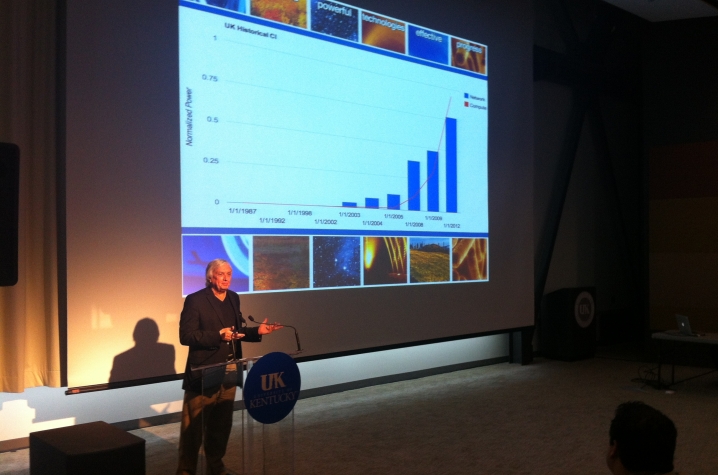UK Takes Academic Supercomputing to Next Level
LEXINGTON, Ky. (Dec. 3, 2012) — The University of Kentucky commemorated 25 years of academic supercomputing with the announcement of the most powerful supercomputer in the university's history and the award of a $1 million "cyber infrastructure" grant from the National Science Foundation. The announcement was part of a cyber infrastructure symposium today, sponsored by UK Information Technology.
With the most recent upgrade, UK deployed a new, $2.6 million, high-performance computing cluster in partnership with Dell Inc. This cluster is more than three times as fast as the one it replaced, with a theoretical maximum of just over 140 teraflops (140 trillion mathematical calculations per second). The cluster contains nearly 5,000 central processing units and 48 high-performance graphics processing units.
"We live in an increasingly hyper-connected, technology-infused global community where our competitive edge is predicated upon the utilization of cutting-edge resources and effective deployment of our intellectual capital," said UK President Eli Capilouto. "Our new supercomputer and cyber infrastructure position us to recruit and retain world-class research scientists who can connect with colleagues across the globe and attract competitive funding to support our growing enterprise as a nationally ranked public research university."
In addition to this investment, the university has received a $1 million competitive "cyber infrastructure" grant from the National Science Foundation, to advance research through software-defined networking.
Software-defined networking revolutionizes the way very large data sets are shared, by allowing researchers and their applications more direct, dynamic control over the flow of data between technical resources and collaborators. This enables better utilization of remote computing resources while improving data integrity/security, and serves overall to expedite research.
"We are competing with some of the top institutions across the country," said Vince Kellen, UK's senior vice provost for academic planning, analytics and technologies, and its chief information officer. "This new high-performance cluster, combined with the cyber infrastructure grant, will really help to keep us in the top group of 20 or 30 universities."
Speakers at the symposium — including Capilouto, Kellen, Computer Science Professor James Griffioen and several researchers who utilize UK's cyber infrastructure in their work — will review UK's advancements in computing over the past quarter-century, explore how cyber infrastructure enhances current research, and offer a glimpse into the future of research computing.
Researchers at UK use cyber infrastructure in a diversity of disciplines, including drug design, materials genome, land use management, nanoscale materials, and the biochemistry of renewable fuels.
Tom Mueller, professor of plant and soil sciences, uses the supercomputer in his research, which is focused on developing techniques to identify where eroded waterways are likely to occur across agricultural fields.
"To calculate terrain attributes on my PC for one county could take a week," Mueller said. "On the supercomputer, it takes only minutes. We plan to do these analyses for the entire state of Kentucky."
Gary Ferland, professor of theoretical astrophysics, is investigating how the chemical elements found on Earth were first formed in stellar furnaces billions of years ago. Ferland developed a large computer program, Cloudy, which is today one of the most widely used in theoretical astrophysics.
"We can build a star, the Orion Nebula, the Crab Nebula, a quasar, or conditions like what happened just after the Big Bang — in the computer, carefully simulate the exact physical processes that occur — and predict the light that is produced," Ferland said. "We can then compare this with what we observe with our telescopes and work backwards to understand what happened, out there and then."
Christina Payne, professor of chemical engineering, is looking into the fundamental nature of proteins, specifically enzymes, and how they interact with their environments. Industrially, enzymes have applications in fields such as green energy, where they are used to convert plant material into biofuels.
"Our molecular simulations are incredibly computationally demanding and require access to high-performance computing resources," Payne said. "The recent hardware upgrade greatly expands our ability to search for molecular-level insights that will inform future protein engineering efforts for biotechnology development."
MEDIA CONTACT: Keith Hautala, (859) 323-2396; keith.hautala@uky.edu






